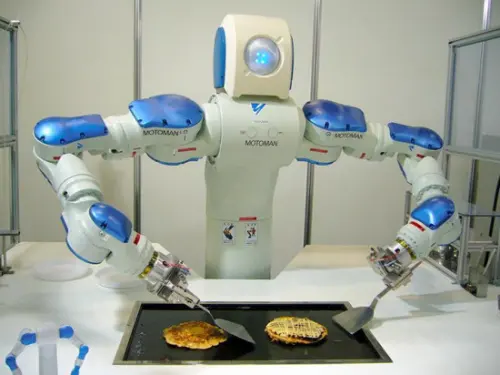Today, AI robot chefs can actually do a lot more. With onboard sensors, optical cameras, and enhanced artificial intelligence technology, these AI robot chefs are fundamentally designed to multitask, executing the movements and movements of professional human chefs in real time.
What is an AI Robot Chef?
Simply put, an AI robot chef is an AI-enhanced robot designed to cook food. One of the latest AI-powered robotic chefs, Moley Robotics is the world’s first fully robotic kitchen, an AI-autonomous system that automates nearly every part of the cooking process. It’s a ceiling-mounted device that works with the entire smart kitchen. It has two arms that slide along ceiling-mounted tracks and is able to adjust the temperature, use the sink, mix and pour ingredients into the pot, and stir the pot. Moley Robotics has pre-programmed recipes that can cook more than 5,000 meals at a time and clean up the food when it’s done.
The robots can learn how to make food through sensors attached to kitchen utensils that analyze recipes. They are also capable of monitoring more than 1,200 parameters per microsecond and can sense touch, smell, sight and hearing. These senses send feedback to their operating systems (OS), creating a learning loop similar to humans. With the help of these features, they can automate many kitchen tasks and learn new skills over time. The AI robot chef has tactile, contact and proximity sensors to log tasks, capture motion and cook recipes. This allows the robot to decipher when ingredients need to be changed, suggest dishes, control calories, and adjust menus for different diets and lifestyles. The AI robot chef is able to teach itself and perform these tasks by storing the information in a database and retrieving it when needed.
By all indications, the world of the 21st century seems ready to welcome the innovations of more AI-powered robot chefs, with experts predicting that by 2025, there will be 482.8 million smart homes. It is estimated that by the end of 2022, the global population will reach 8 billion. This will trigger increased food demand, pressure on the global food industry, and consumer calls for better and sustainable food quality. This is where the AI Robot Chef comes in handy.
The Benefits of an AI Robot Chef
#1: Solve the understaffing problem
AI robot chefs solve the understaffed problem of most restaurants, fast food and high-volume kitchens by supplementing or taking over the work of humans, thereby reducing costs and improving customer experience.
#2: Reduce waste
By assigning the desired ingredients to each meal, the AI robot chef helps reduce food waste and costs by eliminating human error caused by overestimation. In addition, advanced AI robot chefs can monitor the environment of food storage containers to avoid food spoilage.
#3: Smart Kitchen Collaboration
Smart kitchens are now commonplace in most homes, and they are equipped with automatic functions and semi-autonomous appliances that are necessary for an artificial intelligence-enhanced robot chef to function effectively. This reduces the amount of time human chefs spend in the kitchen.
#4: Reduce Pollution
The AI robot chef’s service is to eliminate the risk of contamination caused by foodborne illness. They also encourage savings, increase business profits, and increase customer satisfaction and loyalty.
The Limits of AI Robot Chefs
AI robot chefs cannot handle ingredients for cooking and food preparation such as peeling potatoes or garlic, chopping carrots, chopping vegetables or fruits. AI robot chefs are currently very expensive, making them unaffordable for many. Humans naturally love to cook and trust to eat their food, so it is unlikely that AI robot chefs will completely replace human chefs, but may act as assistants.
the way of the future
Researchers at the University of Cambridge have created an artificially intelligent robot chef that can taste food at different stages of the chewing process. While this is an ongoing project, the ideal result would be an AI-powered robotic chef that can chew anything, applying its enhanced sense of taste in the process. In addition, the AI robot chef needs to have improved taste receptors to have the five basic taste patterns, namely sweet, sour, salty, bitter and salty.
There is still a need to develop an AI robot chef that can better integrate the detailed data it receives into its operating system to ensure greater flexibility, enhanced operations and improved outcomes. Online robotic ghost kitchens are poised to be the next big thing, making it possible for people to create their own menus and recipes and order their meals online. These AI bots will prepare recipes according to given specifications and deliver them to customers in record time.
Overall, a golden age of technological advancement in the food industry appears to have arrived. Although this advancement has been subject to some delays, it is expected that the global acceptance of robotic chef systems accompanied by artificial intelligence will make up for its years of development.




GIPHY App Key not set. Please check settings